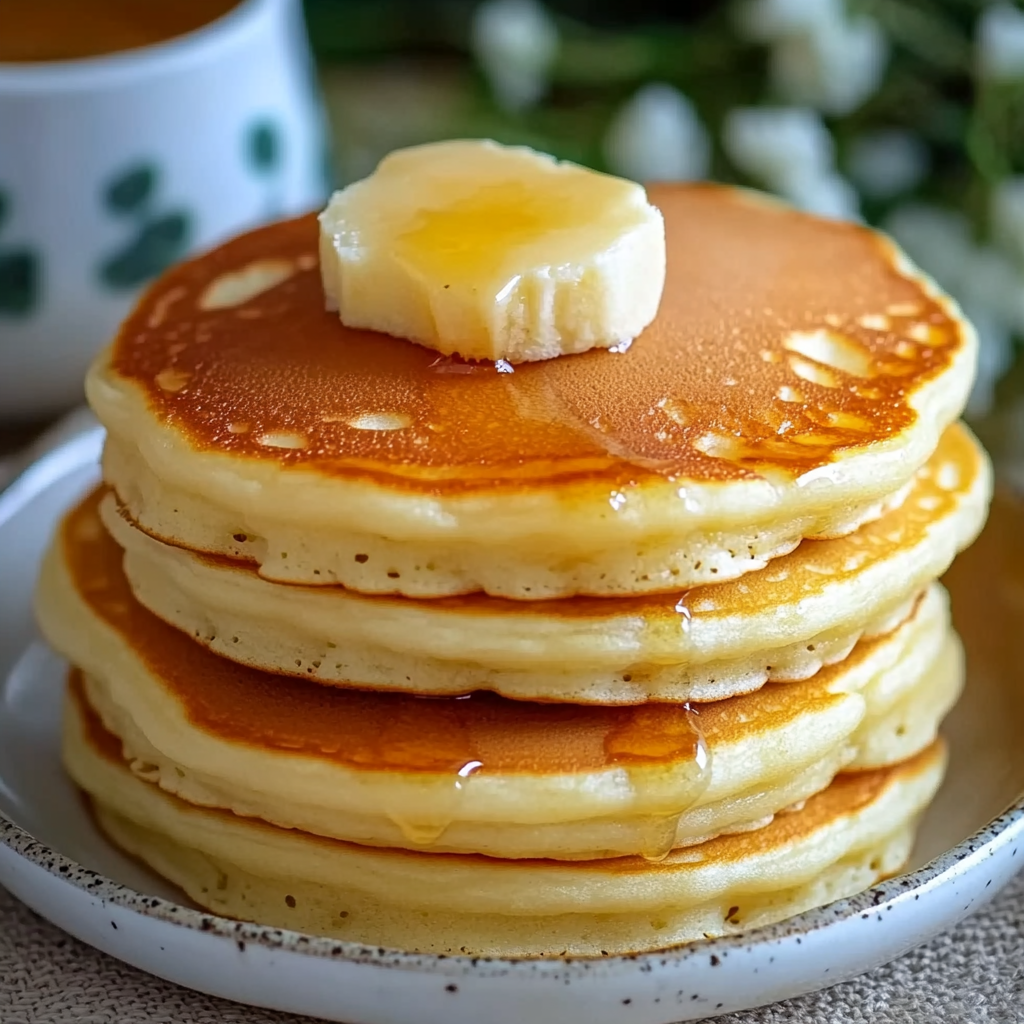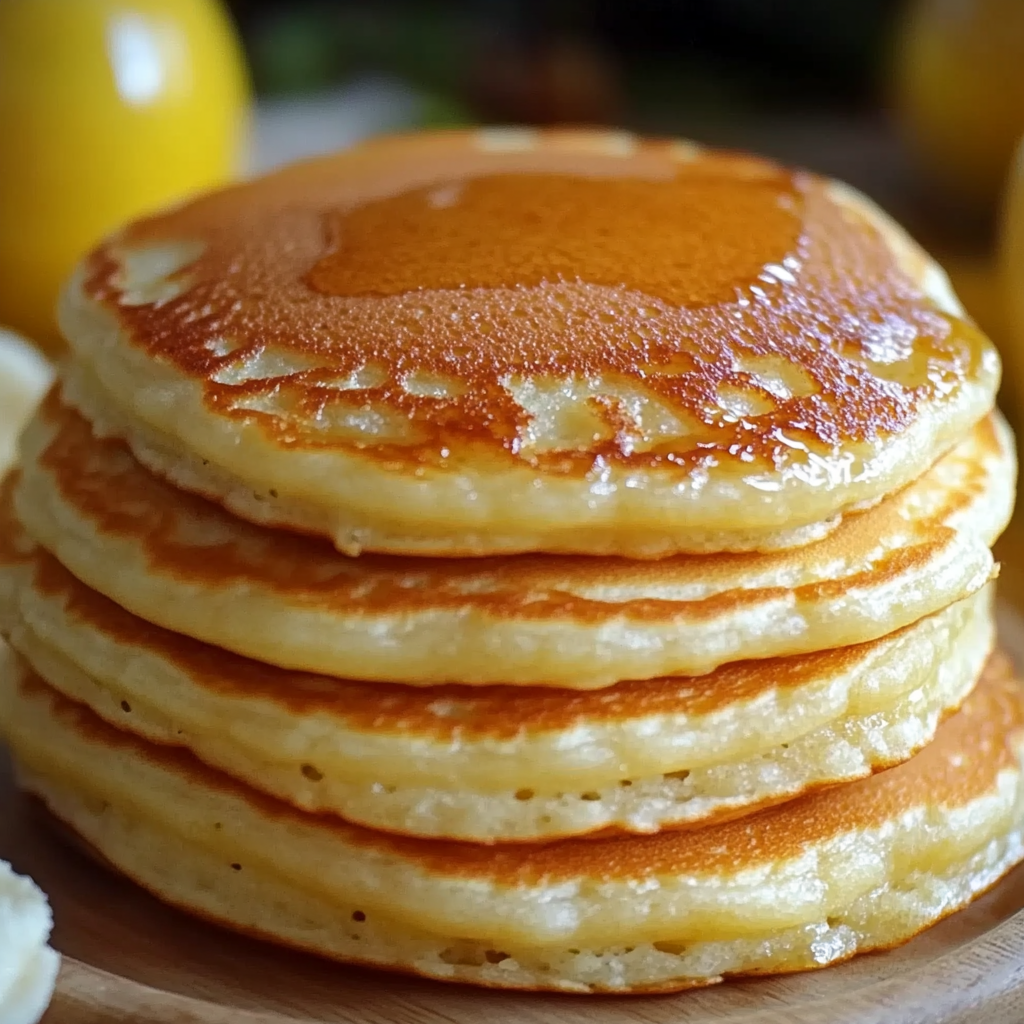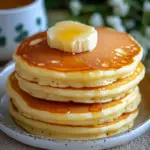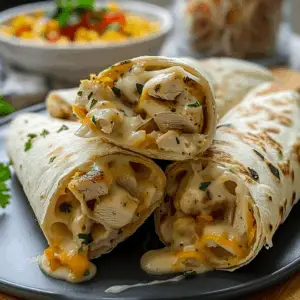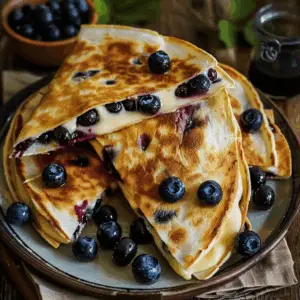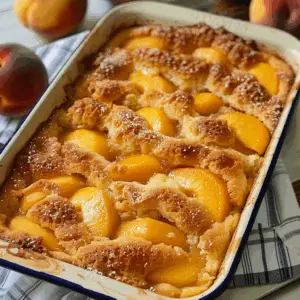There’s nothing quite like a plate of fluffy pancakes to start your morning right. Whether you’re preparing breakfast for your family or enjoying a quiet weekend brunch, these pancakes will quickly become your go-to recipe. Unlike flat or dense pancakes, these are light, buttery, and perfectly soft, making every bite melt in your mouth.
The secret to achieving the perfect texture lies in choosing the right ingredients and following the right technique. If you’ve ever struggled with making pancakes that are too dense or flat, this guide will help you master the art of fluffy pancakes with ease. From selecting the best baking powder to cooking at the right temperature, every detail matters.
Pancakes have been a beloved breakfast dish for centuries, enjoyed in various forms worldwide. In fact, according to Wikipedia, pancakes have been a staple in many cultures, with variations ranging from American-style flapjacks to delicate French crêpes. By understanding what makes a pancake truly fluffy, you can elevate your homemade breakfast game and impress anyone who takes a bite.
Now, before we dive into the step-by-step recipe, let’s first explore the key factors that contribute to a pancake’s fluffiness and why the right ingredients matter.
What Makes a Pancake Fluffy?
Achieving fluffy pancakes isn’t just about following a recipe—it’s about understanding the science behind the ingredients and the cooking technique. The fluffiness of a pancake depends on how well it rises while cooking, which is influenced by several key factors.
1. The Role of Leavening Agents
One of the most critical ingredients for making pancakes fluffy is baking powder. This leavening agent creates air bubbles in the batter, allowing the pancakes to rise. Without it, your pancakes would turn out dense and flat. According to Wikipedia, baking powder works by releasing carbon dioxide gas when mixed with liquid and heat, resulting in a light and airy texture.
To ensure maximum fluffiness:
- Always use fresh baking powder. Expired baking powder won’t produce enough gas to make your pancakes rise.
- Use the right amount—too little won’t create enough air pockets, while too much can give the pancakes a bitter taste.
- If you don’t have baking powder, substitute with a mix of baking soda and an acid like lemon juice or vinegar.
2. The Importance of Not Overmixing
Overmixing the batter is one of the most common mistakes that lead to flat pancakes. When you stir the batter too much, you develop the gluten in the flour, which makes the pancakes tough and chewy instead of light and fluffy.
For the best texture:
- Gently fold the wet and dry ingredients together until just combined. A few lumps in the batter are perfectly fine!
- Let the batter rest for 5-10 minutes before cooking. This allows the ingredients to fully hydrate and the leavening agents to activate, resulting in a softer pancake.
3. The Right Balance of Ingredients
Each ingredient in a pancake recipe plays a crucial role in determining its texture. If you want your pancakes to be extra fluffy, consider these adjustments:
- Use buttermilk instead of regular milk. Buttermilk reacts with baking powder to create more air bubbles, leading to a lighter texture.
- Separate the egg yolks and whites. Beating the egg whites separately and folding them into the batter creates additional lift.
- Use melted butter instead of oil. Butter adds richness and flavor while keeping the pancakes tender. Learn more about its benefits from Wikipedia.
4. Cooking Temperature and Technique
Even if you have the perfect batter, cooking your pancakes at the wrong temperature can ruin their fluffiness. If the pan is too hot, the pancakes will cook too quickly on the outside while remaining raw inside. If it’s too cold, they won’t rise properly.
To get the best results:
- Preheat your pan over medium heat and test it by sprinkling a few drops of water—if they sizzle and evaporate, the pan is ready.
- Grease the pan lightly with butter or oil to prevent sticking without making the pancakes greasy.
- Flip the pancakes at the right time—when bubbles form on the surface and the edges start to look dry.
By following these steps, you can ensure that every pancake you make is perfectly fluffy, golden, and delicious. Now that you understand the science behind it, let’s break down the ingredients and their role in achieving the perfect texture.
Ingredients Breakdown & Their Role
The key to making perfectly fluffy pancakes lies in using the right ingredients in the right proportions. Each ingredient plays a specific role in achieving the ideal texture, flavor, and rise. Let’s break them down:
1. All-Purpose Flour – The Foundation
Flour provides the structure of the pancakes. It contains gluten, which helps hold everything together while still allowing the pancakes to remain soft. The type of flour you use can impact the texture:
- All-purpose flour (recommended for this recipe) creates the perfect balance between fluffiness and structure.
- Whole wheat flour adds a nutty flavor but can make the pancakes denser unless mixed with all-purpose flour.
- Gluten-free flour works as a substitute, but may require an additional binding agent like xanthan gum.
Learn more about flour and its role in baking from Wikipedia.
2. Baking Powder – The Fluff Maker
This is the most crucial ingredient for light and airy pancakes. Baking powder acts as a leavening agent, creating air pockets that make the pancakes rise. If your pancakes are turning out flat, check if your baking powder is still fresh. A simple test:
- Add a small amount of baking powder to hot water. If it fizzes immediately, it’s still active.
- If there’s no reaction, it’s time to replace it.
For those who prefer natural alternatives, baking soda combined with an acidic ingredient (like lemon juice or yogurt) can be used as a substitute. More details on how baking powder works can be found on Wikipedia.
3. Sugar – Sweetness & Caramelization
While sugar mainly adds sweetness, it also helps with browning the pancakes, giving them that perfect golden color. A small amount—about 1 tablespoon—is enough to enhance the flavor without making the pancakes overly sweet.
- White sugar dissolves easily and provides a neutral sweetness.
- Brown sugar adds a slight caramel flavor.
- Honey or maple syrup can be used as natural sweeteners.
4. Salt – The Flavor Enhancer
Salt may seem unnecessary in a sweet recipe, but it plays a vital role in enhancing the overall flavor. It balances the sweetness and prevents the pancakes from tasting bland. Just ½ teaspoon is enough to make a difference.
5. Milk – Moisture & Texture
Milk adds moisture and helps create a smooth batter. The type of milk you use can influence the fluffiness:
- Whole milk is ideal as it provides richness and a creamy texture.
- Buttermilk makes pancakes even fluffier due to its reaction with baking powder.
- Non-dairy alternatives like almond or oat milk work well, but may slightly change the texture.
For more about different types of milk and their effects in cooking, check out Wikipedia.
6. Egg – Structure & Binding
Eggs are responsible for holding the ingredients together and adding lightness to the pancakes. The proteins in eggs set during cooking, giving the pancakes a soft and fluffy texture. Some variations include:
- Extra-fluffy method: Separate the egg whites and beat them until stiff peaks form, then fold them into the batter.
- Vegan alternative: Use flaxseed meal mixed with water or mashed bananas.
7. Melted Butter – Richness & Flavor
Butter adds a delicious buttery flavor while keeping the pancakes moist and tender. You can also substitute it with:
- Coconut oil for a dairy-free option
- Vegetable oil for a neutral taste
For more about how butter enhances baked goods, see Wikipedia.
8. Vanilla Extract – The Flavor Booster
A small amount of vanilla extract enhances the sweetness and adds warm, aromatic notes to the pancakes. If you don’t have vanilla extract, alternatives include almond extract or a bit of cinnamon for extra depth.
By carefully selecting and using these ingredients, you can ensure that your pancakes turn out fluffy, flavorful, and irresistible every time. Now that we understand the role of each ingredient, let’s move on to the step-by-step instructions for making the perfect pancakes.
Step-by-Step Instructions for Perfect Pancakes
Now that you understand the science behind fluffy pancakes and the role of each ingredient, let’s go through the step-by-step process to ensure you get the perfect texture every time. Follow these simple yet crucial steps for pancakes that are light, airy, and golden brown.
1. Mixing the Dry Ingredients
To start, you’ll need to combine the dry ingredients properly to ensure even distribution of the leavening agent:
- In a large mixing bowl, whisk together:
- 1 ½ cups all-purpose flour
- 3 ½ teaspoons baking powder
- 1 tablespoon sugar
- ½ teaspoon salt
- Whisking helps aerate the flour, making the pancakes lighter and preventing clumps.
- For even better texture, sift the dry ingredients to create a finer, fluffier batter.
2. Combining the Wet Ingredients
In a separate bowl, mix the wet ingredients:
- 1 ¼ cups milk (whole milk or buttermilk for extra fluffiness)
- 1 egg, beaten lightly
- 3 tablespoons melted butter, cooled slightly
- 1 teaspoon vanilla extract
Make sure to:
- Whisk well to ensure the egg is evenly distributed.
- Use room-temperature ingredients to help the batter mix more smoothly.
3. Mixing Wet and Dry Ingredients
Now comes the most critical step—combining the wet and dry ingredients without overmixing!
- Pour the wet mixture into the bowl with dry ingredients.
- Using a spatula or wooden spoon, gently fold the ingredients together.
- The batter should be slightly lumpy—this is perfectly normal! Overmixing will develop the gluten, resulting in tough, dense pancakes.
Let the batter rest for 5-10 minutes. This allows the baking powder to activate, ensuring a lighter texture.
4. Preparing the Cooking Surface
The right pan and temperature are crucial for achieving golden, evenly cooked pancakes.
- Use a non-stick skillet or griddle to prevent sticking and ensure easy flipping.
- Preheat the pan over medium heat—not too high, or the pancakes will burn before cooking through.
- Lightly grease the pan with butter or oil, wiping off excess to prevent greasiness.
5. Cooking the Pancakes
- Use a ¼ cup measuring cup to pour batter onto the hot pan. This ensures even-sized pancakes.
- Cook until:
- Small bubbles form on the surface.
- The edges start to look set (about 2-3 minutes).
- Flip carefully using a spatula. Cook for another 1-2 minutes until golden brown.
6. Serving & Toppings Ideas
Serve the pancakes warm, with delicious toppings such as:
- Classic choices: butter, maple syrup, fresh berries
- Creative ideas: whipped cream, chocolate chips, peanut butter, caramelized bananas
- For a protein boost: Greek yogurt or nuts
Want more pancake topping inspiration? Check out Pinterest for creative and delicious ideas.
By following these foolproof steps, you’ll get perfectly fluffy pancakes every time! Now, let’s explore some expert tips to take your pancake game to the next level.
Tips & Tricks for Extra Fluffy Pancakes
Even if you follow the basic steps correctly, a few expert tricks can take your pancakes from good to absolutely perfect. Use these pro tips to make your pancakes extra fluffy, soft, and delicious.
1. Use Fresh Baking Powder
The most common reason pancakes turn out flat is expired baking powder. If your baking powder is more than six months old, it may have lost its effectiveness. To test it:
- Add ½ teaspoon of baking powder to hot water.
- If it fizzes immediately, it’s still good to use.
- If there’s no reaction, replace it with a fresh batch.
2. Let the Batter Rest
After mixing, let the batter sit for 5-10 minutes before cooking. This allows:
- The flour to fully hydrate, making the pancakes softer.
- The baking powder to activate, creating a fluffier texture.
3. Use Buttermilk Instead of Regular Milk
For an even lighter texture, swap regular milk with buttermilk. Buttermilk adds acidity, which:
- Reacts with baking powder, producing more air bubbles.
- Gives the pancakes a slight tang and enhances flavor.
No buttermilk on hand? Make your own by adding 1 tablespoon of vinegar or lemon juice to 1 ¼ cups of milk. Let it sit for 5 minutes before using.
4. Whip Egg Whites Separately
For super fluffy pancakes, try separating the egg whites from the yolks:
- Beat the egg whites until they form soft peaks.
- Fold them gently into the batter right before cooking.
This creates extra air pockets, making the pancakes incredibly light and airy.
5. Control Your Cooking Temperature
If the heat is too high, the pancakes will cook too fast on the outside while staying raw inside. If it’s too low, they won’t rise properly. The ideal way to test the pan:
- Sprinkle a few drops of water on the surface—if they sizzle and evaporate, the pan is ready.
- Cook on medium heat for best results.
6. Keep Pancakes Warm Without Getting Soggy
To keep pancakes warm while cooking multiple batches:
- Place them on a baking sheet in an oven preheated to 200°F (90°C).
- Avoid stacking them immediately, as this can trap steam and make them soggy.
For more pancake hacks, check out this Pinterest guide: Pancake Hacks.
By using these expert techniques, you’ll ensure your pancakes turn out fluffy, golden, and irresistibly delicious every time. Now, let’s look at some common pancake mistakes and how to avoid them.
Common Mistakes & How to Avoid Them
Even the best pancake recipes can go wrong if you make simple mistakes. If your pancakes turn out flat, dense, or unevenly cooked, chances are you’re making one of these errors. Here’s how to fix them!
1. Overmixing the Batter
One of the biggest mistakes people make is stirring the batter too much. This develops gluten, leading to tough, chewy pancakes instead of light and fluffy ones.
✅ Solution:
- Stir the batter gently, just until the dry and wet ingredients are combined.
- A few lumps in the batter are perfectly fine!
2. Using Expired Baking Powder
If your pancakes aren’t rising properly, your baking powder might be too old. Without fresh baking powder, pancakes turn out flat and dense.
✅ Solution:
- Always check the expiration date before using.
- Do a quick fizz test: Mix a small amount with hot water—if it bubbles, it’s still active.
Learn more about how baking powder affects fluffiness on Wikipedia.
3. Cooking at the Wrong Temperature
If your pancakes are burning on the outside but raw inside, your pan is too hot. If they’re taking too long to cook, the heat is too low, and they won’t rise properly.
✅ Solution:
- Use medium heat and preheat the pan properly.
- Sprinkle a few drops of water on the pan—if they sizzle and evaporate, it’s ready.
4. Flipping Too Early or Too Late
Flipping at the wrong time can ruin your pancakes’ texture. If you flip too soon, they’ll collapse. If you wait too long, they’ll be too firm.
✅ Solution:
- Flip when bubbles appear on the surface and the edges start to dry.
- Use a thin spatula for a smooth flip.
5. Not Letting the Batter Rest
Skipping the resting step means you’re missing out on maximum fluffiness. Resting allows the flour to absorb moisture and the baking powder to activate.
✅ Solution:
- Let the batter sit for 5-10 minutes before cooking.
By avoiding these common mistakes, you’ll get perfectly fluffy pancakes every time. Next, let’s answer some frequently asked questions about making the best pancakes!
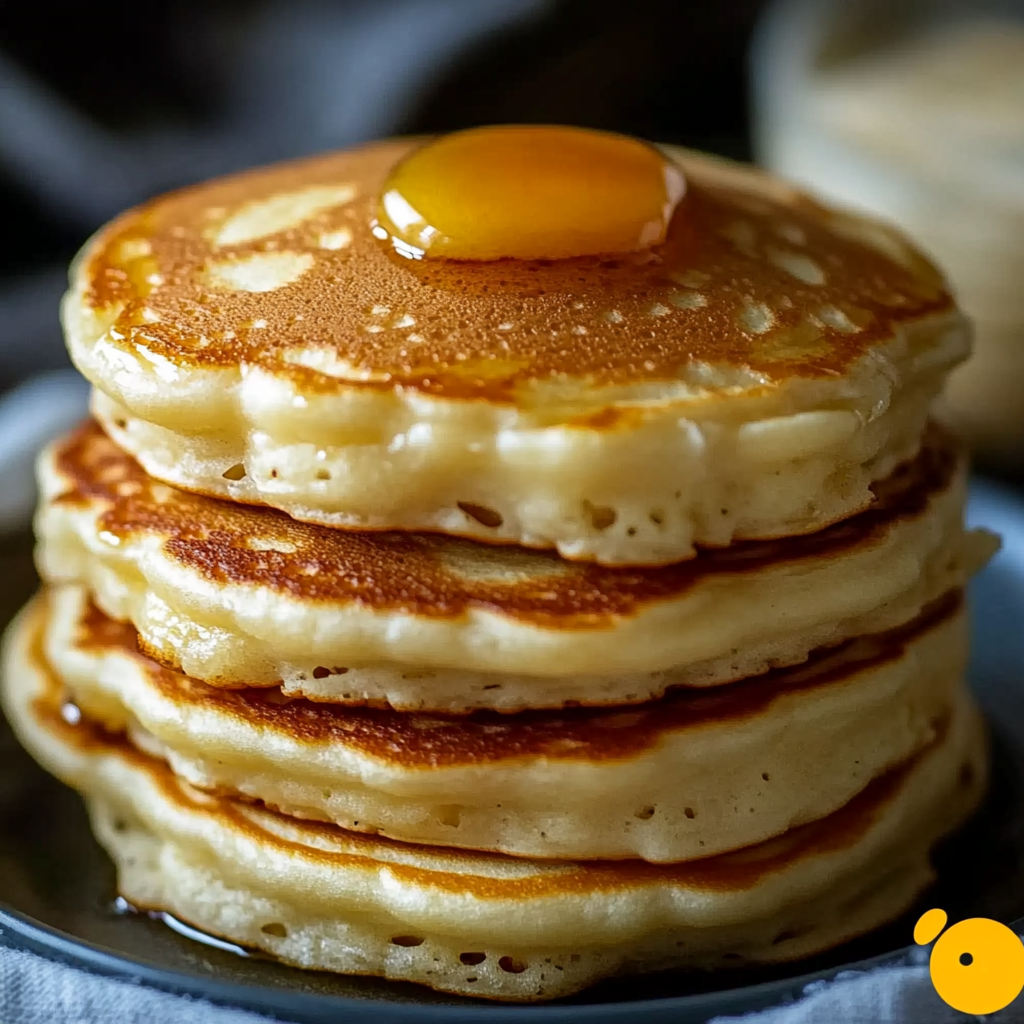
FAQs
Here are some of the most frequently asked questions about making fluffy pancakes. If you’ve ever had trouble with your pancakes, these answers will help you perfect your technique!
1. Can I Make the Batter Ahead of Time?
Yes, but with some precautions. Pancake batter contains baking powder, which starts reacting as soon as it’s mixed with liquid. If left too long, it may lose its rising power.
✅ Solution:
- Store the batter in the fridge for up to 24 hours.
- Give it a gentle stir before cooking (don’t overmix!).
- For best results, mix the wet and dry ingredients separately and combine them right before cooking.
2. What Can I Use Instead of Baking Powder?
If you’re out of baking powder, you can make a substitute using baking soda and an acidic ingredient.
✅ Alternative:
- Mix ¼ teaspoon baking soda with ½ teaspoon lemon juice or vinegar for every 1 teaspoon of baking powder needed.
Learn more about how leavening agents work on Wikipedia.
3. Can I Make These Pancakes Dairy-Free?
Absolutely! You can swap out milk and butter for dairy-free alternatives without sacrificing fluffiness.
✅ Substitutes:
- Milk: Use almond milk, oat milk, or coconut milk.
- Butter: Swap for coconut oil, margarine, or plant-based butter.
4. Why Are My Pancakes Sticking to the Pan?
If your pancakes are sticking, it’s likely due to an unseasoned or improperly heated pan.
✅ Fixes:
- Use a non-stick pan or a well-seasoned cast iron skillet.
- Lightly grease the pan with butter or oil, then wipe off excess to prevent burning.
- Make sure the pan is properly preheated before adding the batter.
Find more pancake cooking hacks on Pinterest.
5. How Do I Store and Reheat Leftover Pancakes?
Pancakes are best enjoyed fresh, but you can store them for later without losing texture.
✅ Storage Tips:
- Fridge: Store in an airtight container for up to 3 days.
- Freezer: Stack pancakes with parchment paper in between and freeze for up to a month.
✅ Reheating Methods:
- Microwave: 15-20 seconds per pancake.
- Oven: Place pancakes on a baking sheet at 350°F (175°C) for 5-10 minutes.
- Toaster: A quick way to restore crisp edges.
The Best Fluffy Pancakes – Don’t Lose This Recipe!
Say goodbye to flat, dense pancakes and hello to the fluffiest, most delicious pancakes you’ve ever made! This no-fail recipe ensures soft, buttery, golden-brown pancakes every time. Whether you’re making breakfast for the family or treating yourself to a weekend brunch, these pancakes are easy to whip up and guaranteed to impress.
With simple ingredients like flour, baking powder, eggs, milk, and butter, you can create light, airy pancakes that melt in your mouth. The secret? A few expert tips, like letting the batter rest, using fresh baking powder, and cooking at the perfect temperature.
✨ Perfect for: Breakfast, brunch, or even a sweet snack.
🥞 Pairs well with: Maple syrup, fresh berries, whipped cream, or your favorite toppings.
- Author: Clara
Ingredients
- 1 ½ cups all-purpose flour
- 3 ½ tsp baking powder
- 1 tbsp sugar
- ½ tsp salt
- 1 ¼ cups milk
- 1 egg
- 3 tbsp melted butter
- 1 tsp vanilla extract
Instructions
In a large bowl, whisk together the flour, baking powder, sugar, and salt.
In a separate bowl, mix the milk, egg, melted butter, and vanilla extract until well combined.
Gradually add the wet ingredients to the dry ingredients, stirring gently until just combined. Do not overmix; lumps are okay.
Heat a non-stick pan or griddle over medium heat and lightly grease with butter or oil.
Pour about ¼ cup of batter onto the pan for each pancake. Cook until bubbles form on the surface and the edges look set, about 2-3 minutes.
Flip and cook for another 1-2 minutes, until golden brown and cooked through.
Serve warm with your favorite toppings like syrup, butter, or fresh fruit.
Notes
✔ Don’t Overmix: The batter should be slightly lumpy to keep the pancakes light and fluffy.
✔ Check Your Baking Powder: Expired baking powder won’t give your pancakes the proper rise.
✔ Let the Batter Rest: Allowing the batter to sit for 5-10 minutes helps create the best texture.
✔ Perfect Flipping Time: Flip when bubbles appear on the surface and the edges start to dry.
✔ For Extra Fluffiness: Try using buttermilk or whipping egg whites separately before folding them in.
✔ Keep Pancakes Warm: Place cooked pancakes in a 200°F oven while you finish cooking the rest.
Now, grab your ingredients and get ready to make the best fluffy pancakes ever! 🥞✨
